Coin Values Moving with Precious Metals: Up-Dated 12/29/2025: Gold $4449 | Silver $75.46
1929 Penny Value
Appraising these wheat cents involves judging a few key areas. 1929 penny value is verified by three main factors: Date | Mint Mark | Condition
Proceed through a step by step process of identifying each. Mint marks and condition are key to 1929 cents. Collectors seek higher condition examples and premiums begin to rise quickly for the scarce varieties.
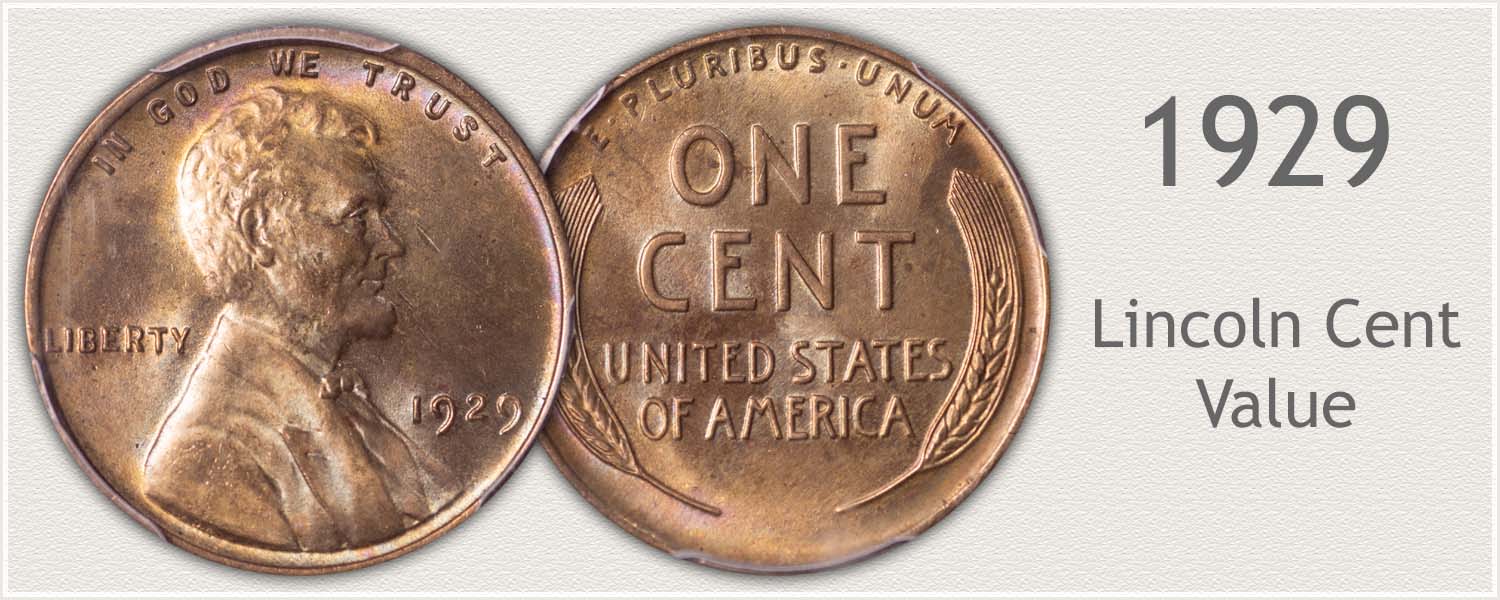
Steps Leading to Value:
- Step 1: Date and Mintmark Variety – Identify each date and its mintmark variety.
- Step 2: Grading Condition – Judge condition to determine grade.
- Step 3: Special Qualities – Certain elements either enhance or detract from value. Images are used to visualize the key elements needed.
| 1929 Lincoln Penny Value | ||||
|---|---|---|---|---|
| Condition of Coin | ||||
| Date | Good | Fine | Extremely Fine | Uncirculated |
| 1929 Lincoln Penny Value Up-Dated | 2025 | |||
| 1929 | $0.14 | $0.62 | $1.83 | $5 |
| 1929 D | $0.48 | $1.06 | $4.66 | $18 |
| 1929 S | $0.50 | $1.34 | $5.11 | $16 |
Complete the appraisal process verifying date, determine mint mark and judging condition. Wheat pennies span a long run 1909 to1958. 1929 pennies are among the group seldom found in higher condition, adding to their scarcity.
Collections are formed by including the branch mint varieties struck. Identifying mint marks helps narrow the position on the value chart. Each coin is listed by mint.
Confirm Date and Mint correctly and proceed to judging condition in a step by step manner.
Step 1: | Date and Mintmark Combination
Identify Variety and Value of 1929 Penny
Varieties of 1929 wheat pennies include coins from Philadelphia, Denver and San Francisco mints. Many are available to collectors today. Stand-out value is found in mintmarks and grade.
1929 Lincoln Penny
No Mintmark Under Date: Philadelphia Mint Struck the Coin
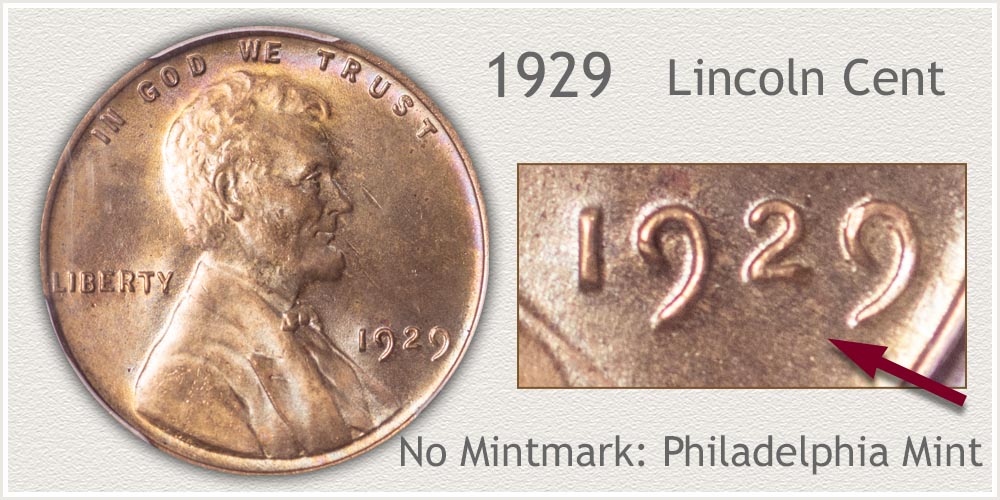
Answering to demand from the economy for minor coinage, Philadelphia mint struck a large number of cents in 1929. Overtime shifts were required to strike 185,262,000 pennies. A rarity scale notes these as: Abundant.
Worn, often very worn examples are the typical 1929 condition of these coins. Those with detail remaining in Lincoln's hair and beard are in favor by collectors.
1929-D Lincoln Penny
"D" Mintmark Under Date: Denver Mint Struck the Coin
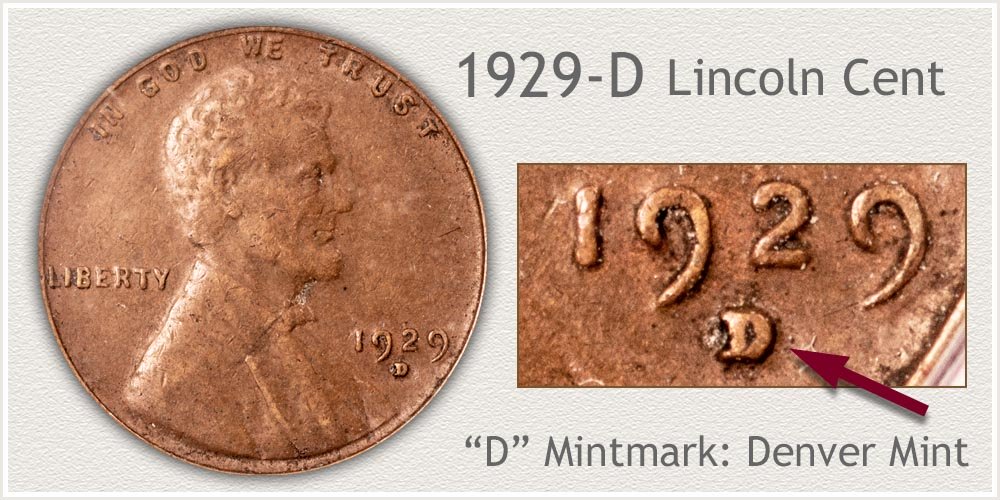
Surviving numbers of Denver 1929 cents on a rarity scale are: Abundant. Many are in low condition however. A stronger market exists for coins with light wear and crisp details remaining.
Date and mint variety collecting is how most collections are formed. As these collections are assembled attention to eye appeal further defines the approach. Denver cents of 1929 become a greater challenge to find with light wear. Sharpe details to lettering along the rim and details within the coat and bowtie of Lincoln are examples with greatest demand.
1929-S Lincoln Penny
"S" Mintmark Under Date: San Francisco Mint Struck the Coin
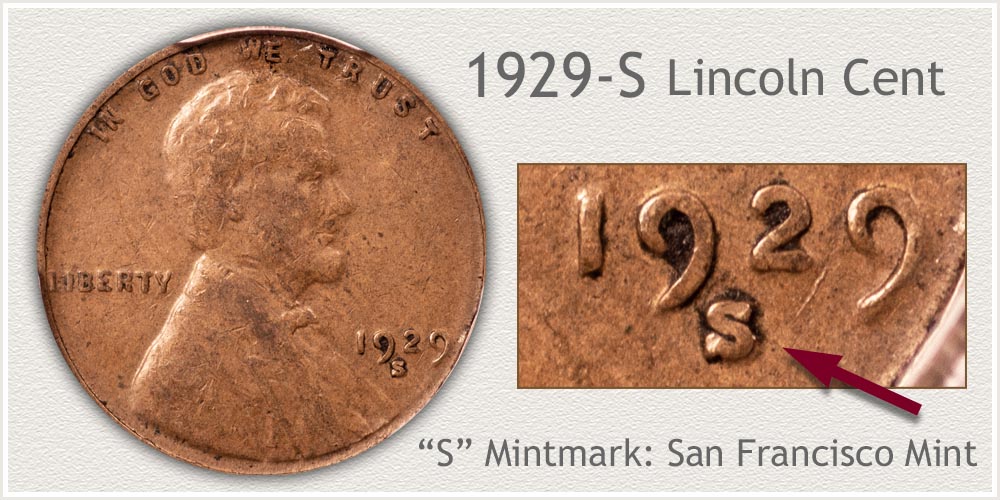
Supplying the west coast with cents required the San Francisco mint to strike 50,148,000 pennies in 1929. Abundant numbers survive today, most heavily worn. Collectors who underpin the market for these old pennies are always looking for eye appealing S mintmark pennies.
Desirable coins are ones with surfaces free from distracting marks and large areas of dark color. Inspect both sides of your coin. A circulated coin with even tan to brown color combined with a lack of rim dents and noticeable marks to the surface is preferred by collectors.
Step 2: | Judge Condition to Identify Grade
Examine Condition of 1929 Penny
Grade of an old penny is a definition used by collectors and dealers defining its condition. Grades are listed along the rows in the value chart. Each coin is judged, wear and surface preservation are noted. A comparison with the images of each grade visualizes these different grades.
Preserve aesthetic value by examining these old pennies over a soft surface and avoid coughing or sneezing. Copper reacts to humidity and moisture.
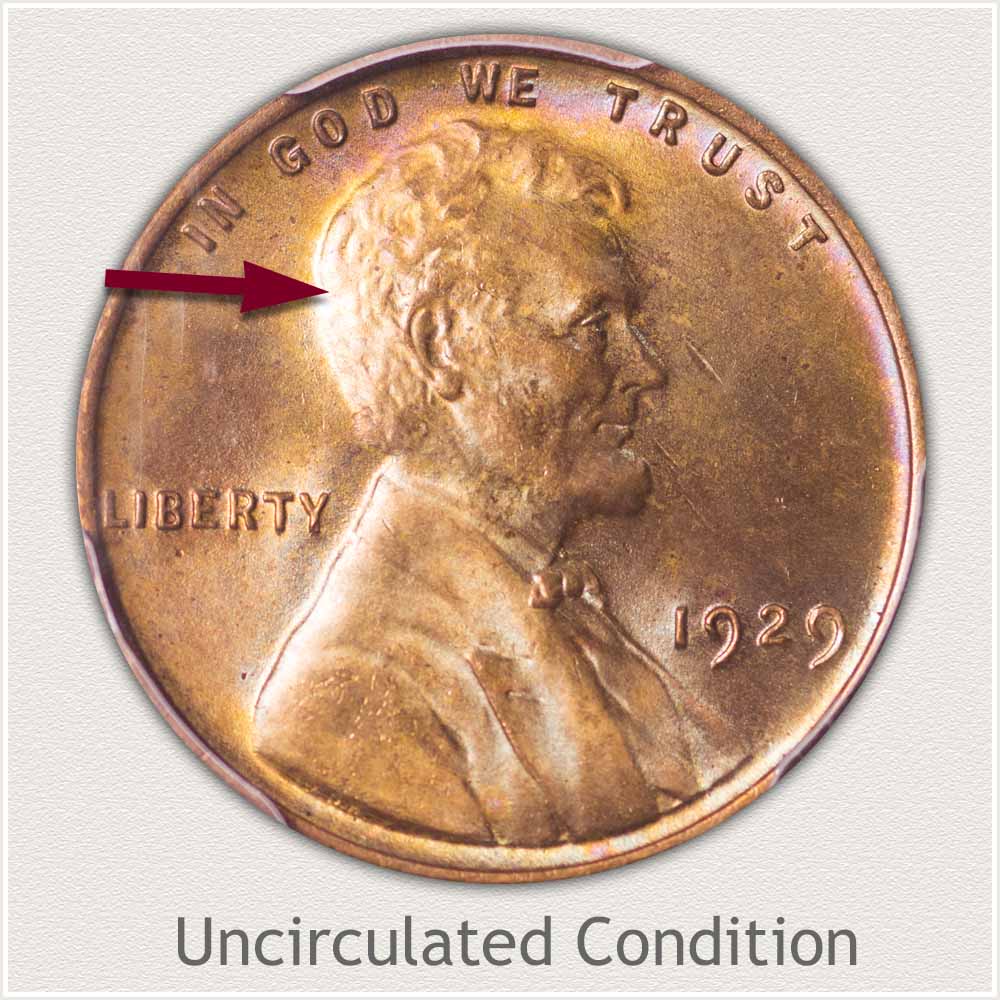
Uncirculated Grade: Sought by collectors are wheat cents in mint state - uncirculated grade. These are coins representing the highest condition. No wear to the surface is the key factor deciding the grade.
Full details are noted to the hair surrounding Lincoln's ear. Just above the ear is a high relief area prone to wear. Inspect the surface looking for smooth texture and color change. Just behind the ear note all smaller waves of hair remain without any smoothness of texture.
A further examine shows the fields of this 1929 mint state cent are free of spotting, indicating a well-preserved cent. Strong eye appeal adds to strong value.
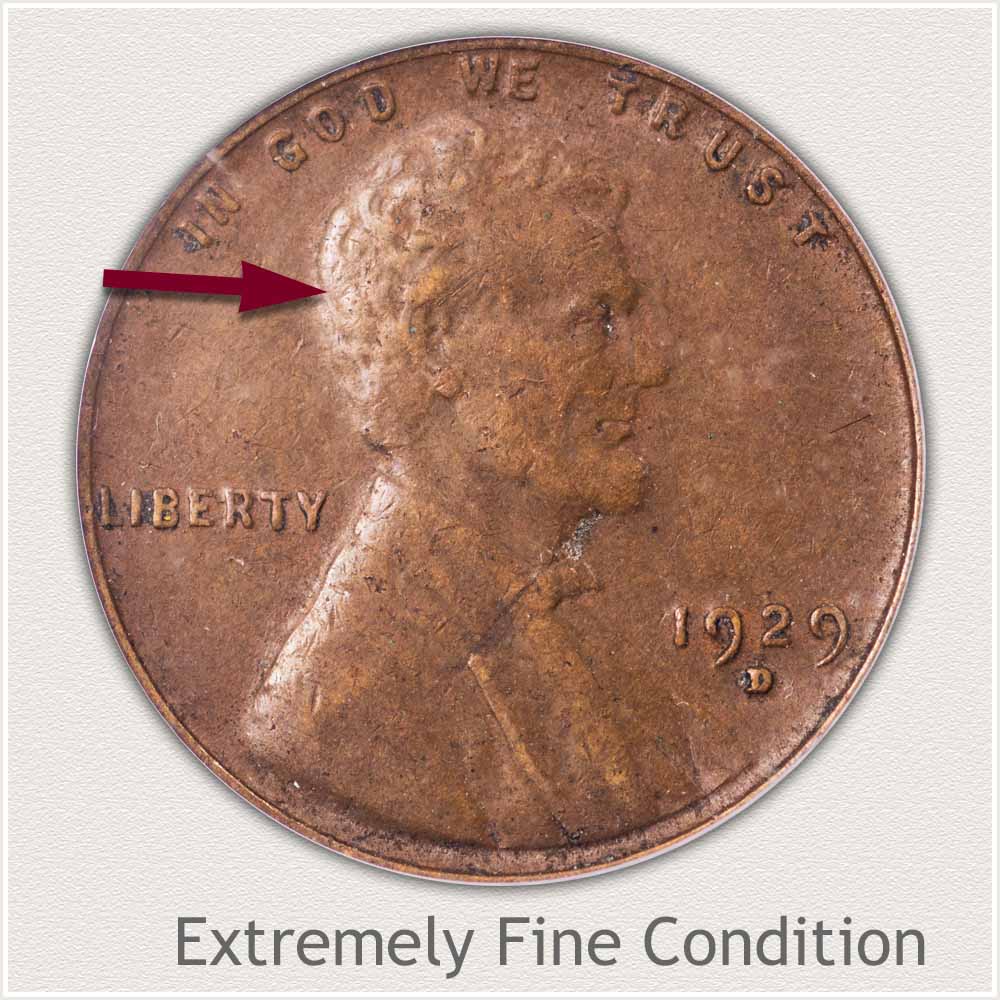
Extremely Fine Grade: A small amount of metal has worn away on high points of an Extremely Fine grade wheat penny. Slight wear is important to remain in the grade. Once major details begin to merge and smaller details are missing a lower grade is needed to describe condition.
An area helpful to judging condition, is Lincoln's hair just above and behind his ear. Small flat areas of just beginning to show on the high spots of the waves of hair. A small connection to the ear is evident. All hair detail behind the ear is worn slightly but separated.
Appeal of the example 1929-D penny is due to the strong, well defined portrait, legends, and a very strong date. Light toning contrasted with deeper shades highlight these major features.
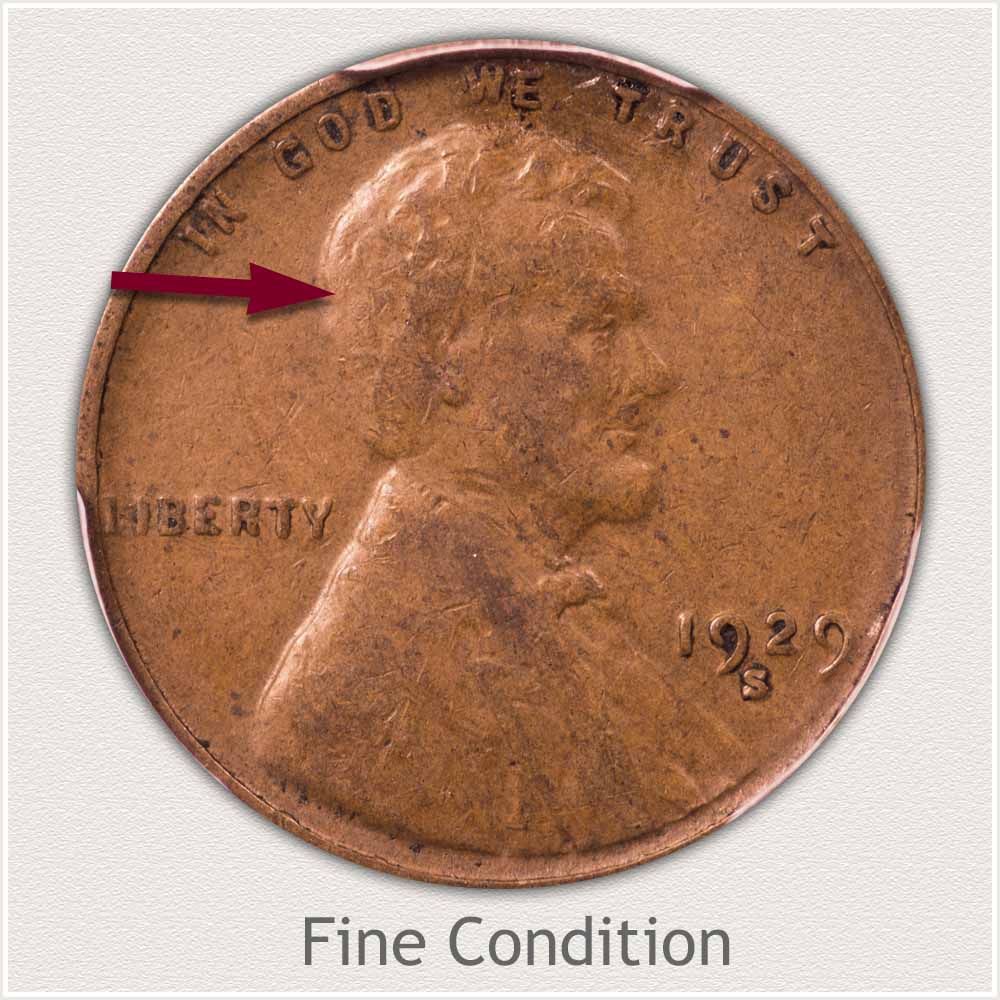
Fine Grade: Large areas of flatness are noticeable helping define a wheat cent in Fine grade. Many high relief areas are now smooth with loss of contour.
Wear has removed the hair above Lincoln's ear and both are merged together. Wear continues behind the ear, flattening some waves of hair. Note a degree of detail remains of the hair behind his ear placing this penny solid for the grade.
Despite a moderate degree of wear, this 1929-S penny is still sharp in appearance. Lending to its eye appeal is the crisp look of the date and lettering. Major contours of Lincoln's portrait remain in high relief adding to its charm.
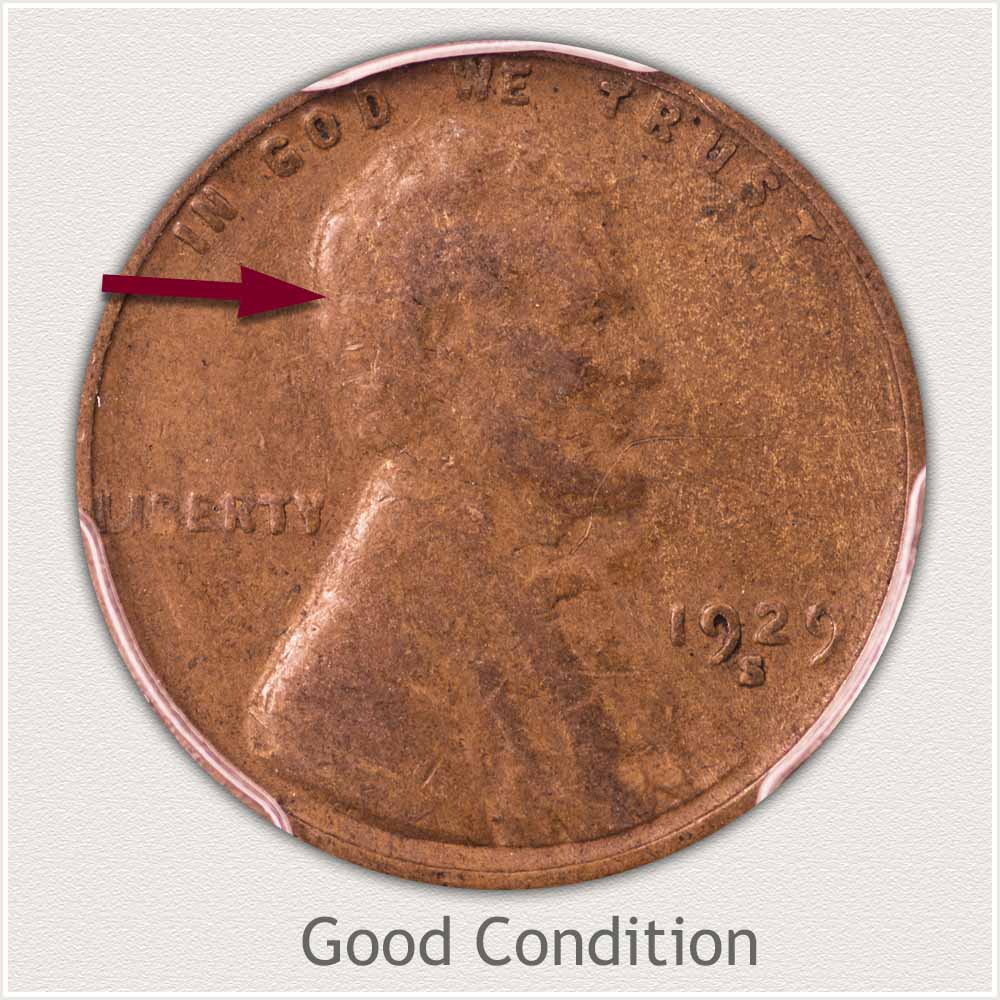
Good Grade: Wide-spread areas of flatness over the portrait defines a wheat cent in the Good grade. Lincoln is mostly an outline but remains raised from the field of the coin.
Hair detail behind Lincoln's ear is missing, waves of hair are now worn smooth. His ear is slightly visible, but any traces of hair detail is gone. A connection of the contour of his cheek and hair is visible.
Minor weakness to letters of "Liberty" is noted. Overall view of this 1929-S is positive. Date and remaining legends are clearly readable and toning is evenly distributed without discoloration. An appealing, affordable wheat cent in demand by beginning and young collectors.
Video | Grading Lincoln Wheat Pennies
Every series of coin is unique in different factors determining grade. Grading Lincoln Wheat Pennies using video, images, and descriptions focus on elements needed to accurately grade and value the series.
Step 3: | Special Qualities Enhancing Value
Collector Preference and 1929-S Penny Value
Keeping in mind collectors are influential in setting values. It is their preferences forming a base to how much a coin is worth. Imaged is a nice 1929-S Lincoln cent. It shows light wear evenly distributed over the entire surface. This coin appeals to collectors because of its affordability, part of the early years of the series, and its minting at San Francisco.
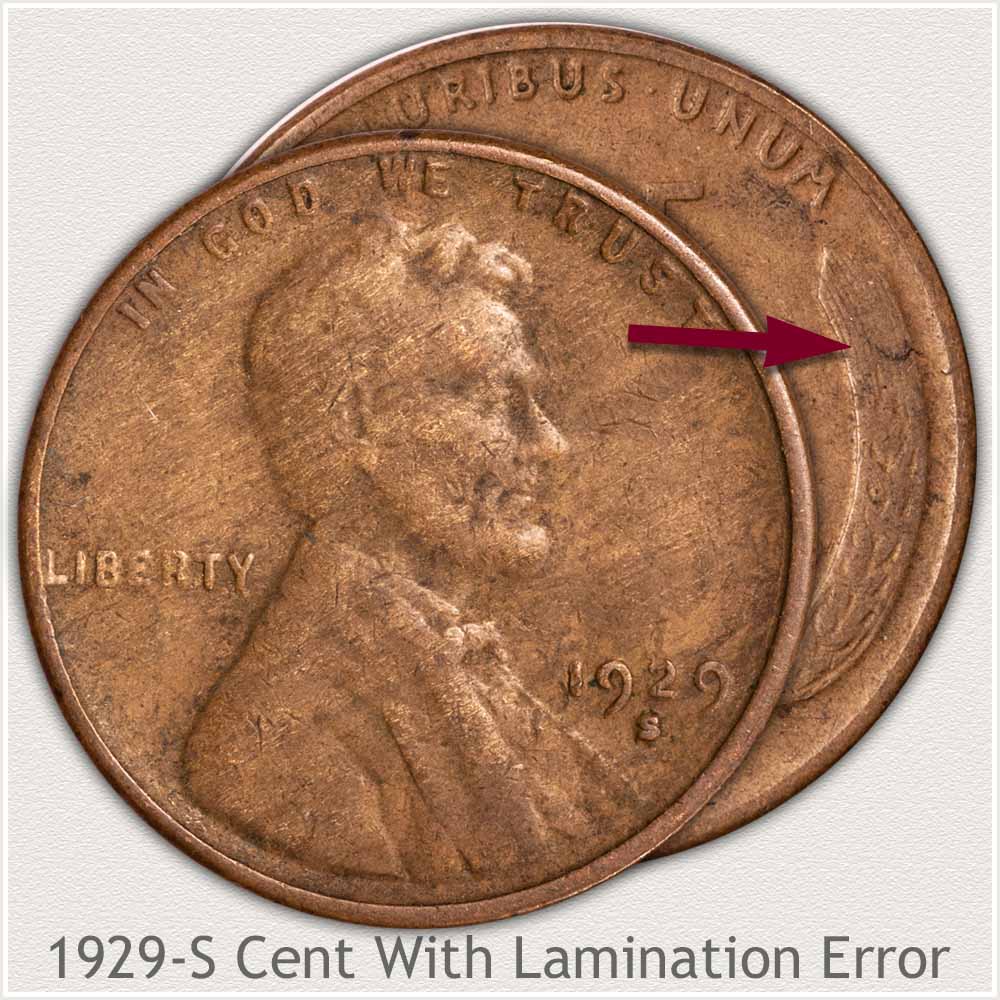
Placing a value on this particular coin must take into account its special quality. On the reverse is a small lamination flake affecting the surface qualities. Laminations are imperfections showing as splits or flakes on the surface, the result of alloy mixing and rolling the metal into strips. Question now becomes, does this minting error add or subtract from value?
A lamination defect on a coin is possible in all sizes. Large dramatic laminations, extending rim to rim are highly visible and interesting examples of a fault in the minting process. Small laminations are more common and on the example is located on an important design feature. A collector is likely to pass on this coin in favor of one without a "distraction". In this case an error, lowers value, despite being mint made.
Subtleties in value is measured in terms of eye appeal. Small laminations often become detrimental, "spoiling" an otherwise nice coin. Large laminations are potentially "fascinating" sparking an interest into the minting process.
ReferencesUS Mint. 1930 US Mint Annual Report https://nnp.wustl.edu/library/publisherdetail/51
Coin Values | CoinStudy Articles
Value chart spans the Wheat design years 1909 through 1958 of Lincoln cents. From uncirculated coins collected by advances collectors to worn examples an affordable collection popular with young collectors. Identify date, mint and condition; a wide range of values is found and identified.
Storing your coins correctly preserves value. Single high value coins need protection from elements in the air and contact to their surfaces. Large quantities of coins are conveniently housed in special holders. Safe methods are explored.
★ Coin Values Discovery finds 1929 Penny Value and...
All US coin values. Recognize your old coins using the image links leading to value charts. Date | Mintmark | Condition are considered; all described and imaged within each series. Surprising value is often found in the smallest of detail.